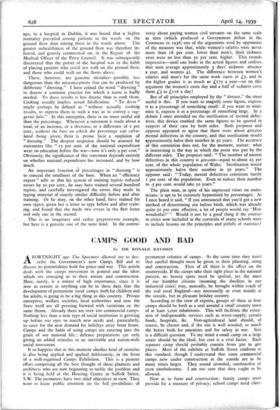CAMPS GOOD AND BAD
By SIR RONALD DAVISON
AFORTNIGHT ago The Spectator allowed me to des- cribe the Government's new Camps Bill and to discuss its potentialities both for peace and war. This article deals with the camps movement in general and the ideas which are emerging as to their nature and construction. Here, surely, is a matter of high importance, since it is now as certain as anything can be in these days that the development of permanent rural camps, both for children and for adults, is going to be a big thing in this country. Private enterprise, welfare societies, local authorities and now the State itself are all pressing forward with variations on the same theme. Already there are over 10o commercial camps. Nothing less than a new type of social institution is growing up before our eyes to match new needs and, particularly, to cater for the new demand for holidays away from home. Camps and the habit of using camps are entering into the grain of our national life ; defence preparations are only giving an added stimulus to an inevitable and nation-wide social movement.
It so happens that at this moment another kind of stimulus is also being applied and applied deliberately, in the form of a well-organised Camps Exhibition. This is a pioneer effort comprising all the best thought of those planners and architects who are now beginning to tackle the problem and it is being held at the Housing Centre in Suffolk Street, S.W. The promoters have two chief objectives in view. They want to focus public attention on the full possibilities of permanent colonies of camps. At the same time they insist that careful thought must be given to their planning, siting and construction. First of all there is the effect on the countryside. If the camps take their right place in the national pattern, no beauty spots need be spoiled, yet the mass of our humbler citizens (meaning the dwellers in our industrial cities) may, annually, be brought within reach of the real rural England—not necessarily or even mainly at the seaside, but in pleasant holiday country.
According to the view of experts, groups of three or four camps should be built as a unit around a small country town of at least 5,000 inhabitants. This will facilitate the exten- sion of indispensable services such as water-supply, certain foods, hospitals, &c. Non-agricultural land should, of course, be chosen and, if the site is well wooded, so much the better both for amenities and for safety in war. Size is a difficult question. To my mind a small camp on a large estate should be the ideal, but cost is a vital factor. Each separate camp should probably contain from 30o to 400 places. Most of the exhibits at Suffolk Street conform to this standard, though I understand that some commercial camps now under construction at the seaside are to be many times larger. They sound crowded, unattractive or even unwholesome. I am not sure that they ought to be allowed.
Now as to form and construction: family camps must provide for a measure of privacy; school camps need class- rooms and dormitories. Both kinds need administrative offices, recreation rooms, playing-fields and water for swim- ming. The designers think mostly in terms of timber con- struction on concrete foundations, but there are pleasant and unpleasant uses of timber. So far, many of the British examples are much inferior to the Scandinavian and Ameri- can styles. They look like, and in fact are no more than, army hutments. The exhibition shows that British archi- tects can do better than this ; they can achieve charming and original results and still keep the capital costs down to £50 a place or less, including the price of the land.
Probably the best achievement so far is the Workers' Travel Association's camp at Corton, Suffolk. This is made of breeze blocks and provides 36o places at a capital cost of £80 a place. When I visited it on a sunny day last August it looked very good and cheerful, but the site on the bare cliff-edge was rather bleak. If only camp promoters could be weaned away, or indeed forcibly excluded, from the actual sea-shore, surely it would be better for all parties. The architects would find sites more naturally fitted for human habitation, more sheltered and more beautiful. And the public might hope to preserve some of the few remain- ing stretches of the English coast line as Nature made it.
The camps movement is growing fast ; its claims are irre- sistible for the purposes of peace even more than for those of war. But it has its dangers. We do not want to see a thousand new suburbias planted in the pleasant places of England, not to mention Scotland and Wales. Local authori- ties already possess certain regulatory powers, but is not this the right moment to secure some kind of unified national control and guidance over siting and size and design? Here, surely, is matter for our town and country planners.







































 Previous page
Previous page